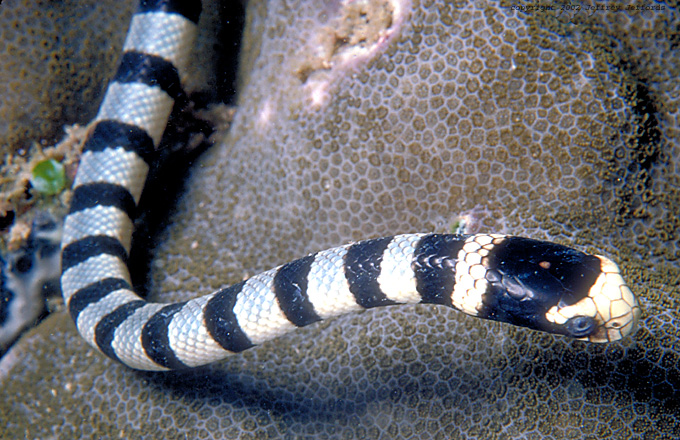 |
Sea kraits are a type of sea snake. Sea snakes are divided into two subfamilies, Laticaudinae and Hydrophiinae, with the former of the two distinguished from other sea snakes by the fact they are amphibious (lives on land and water), versus aquatic (never leaving the water). The sea krait shown here is oviparous, returning to land to lay its eggs, versus other true sea snake species that are viviparous, bearing their young in the water (subfamily Hydrophiinae, aquatic sea snakes). Amphibious sea kraits, members of subfamily Laticaudinae, have specialized ventral scales for crawling on land. Unlike eels, sea snakes are reptiles and have scales. This one is about 18 inches (46 cm) in length. All 50 or so species of sea snakes are venomous, and some are known to have venom ten times as strong as rattlesnake venom, making them among the most potentially dangerous of all animals. Fortunately for divers, they have short fangs and are usually quite docile; this one scarcely paid attention to my stalking, even as I placed my camera lens only about an inch from its head to get some photographs. It returned to the surface almost exactly every 15 minutes from a depth of about 35 feet, breaking the surface for only a split second to take a breath of air. On the bottom, it slowly crawled along, poking its head under coral crevices and under debris, foraging for small fish or perhaps eel prey. Most sea snakes feed this way, though at least one species, Pelamis platurus, is pelagic. A sea snake's paddle-shaped tail is useful for swimming, but otherwise these reptiles look very much like their land cousins, even down to the forked tongue it uses during its search. Most cases of people being bitten by sea snakes involve fishermen bitten when sorting through a catch from a net. The venom is composed of powerful neurotoxins (affect nervous system) and sometimes myotoxins (affect skeletal muscles), with a fatal dose being about 1.5 milligrams. Most sea snakes can produce 10-15 mg of venom. Identification: Laticauda colubrina Common name: Banded Sea Krait or Yellow-lipped Sea Krait |

